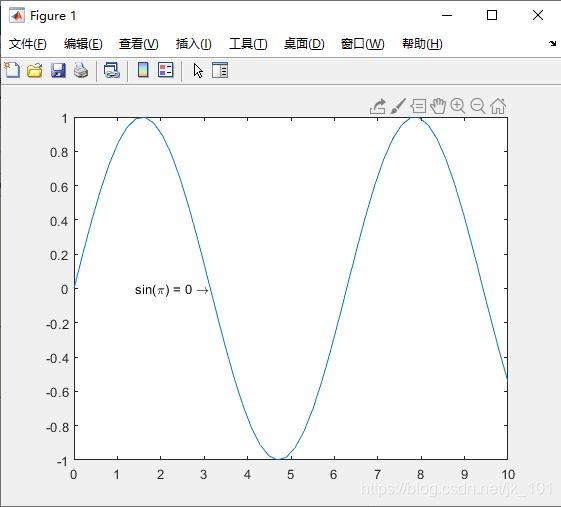Matlab中向图中添加文本
目录
文本位置
文本对齐方式
字体大小
设置文本属性
多行文本
带有变量值的文本
坐标区外部的文本
向图中添加文本是此示例说明如何向图中添加文本、控制文本位置和大小以及创建多行文本。
文本位置
使用 text 函数在特定数据点旁边添加文本。在本例中,为点 (π,sin(π)) 添加文本。text 函数的前两个输入参数指定位置。第三个参数指定了文本。
默认情况下,text 支持一部分 TeX 标记。使用 TeX 标记 \pi 表示希腊字母 π。通过包含 TeX 标记 \leftarrow,显示一个指向左侧的箭头。有关标记的完整列表,可以参考图文本中的希腊字母和特殊字符。
x = linspace(0,10,50);
y = sin(x);
plot(x,y)
txt = '\leftarrow sin(\pi) = 0';
text(pi,sin(pi),txt)文本对齐方式
默认情况下,指定的数据点位于文本的左侧。通过将 HorizontalAlignment 属性指定为 'right',使数据点出现在文本右侧。使用指向右侧而不是左侧的箭头。
x = linspace(0,10,50);
y = sin(x);
plot(x,y)
txt = 'sin(\pi) = 0 \rightarrow';
text(pi,sin(pi),txt,'HorizontalAlignment','right')字体大小
通过将 FontSize 属性设置为 text 函数的名称-值对组参数,指定文本的字体大小。使用 title、xlabel、ylabel 或 legend 函数时,可以通过类似的方法更改字体大小。
x = linspace(0,10,50);
y = sin(x);
plot(x,y)
txt = '\leftarrow sin(\pi) = 0';
text(pi,sin(pi),txt,'FontSize',14)设置文本属性
text 函数用于创建 Text 对象。Text 对象具有可用来自定义文本外观的属性,例如 HorizontalAlignment 或 FontSize。
可以通过两种方式设置属性:
-
在 text 命令中使用名称-值对组,例如 'FontSize',14。
-
使用 Text 对象。可以将 Text 对象作为 text 函数的输出参数返回,并将其赋给某个变量,例如 t。然后,使用圆点表示法设置属性,例如 t.FontSize = 14。
对于此示例,使用圆点表示法而不是名称-值对组来更改字体大小。
x = linspace(0,10,50);
y = sin(x);
plot(x,y)
txt = '\leftarrow sin(\pi) = 0';
t = text(pi,sin(pi),txt)
t =
Text (\leftarrow sin(\pi) = 0) with properties:
String: '\leftarrow sin(\pi) = 0'
FontSize: 10
FontWeight: 'normal'
FontName: 'Helvetica'
Color: [0 0 0]
HorizontalAlignment: 'left'
Position: [3.1416 1.2246e-16 0]
Units: 'data'
Show all properties
如下所示:
x = linspace(0,10,50);
y = sin(x);
plot(x,y)
txt = '\leftarrow sin(\pi) = 0';
t = text(pi,sin(pi),txt);
t.FontSize = 14;多行文本
使用字符向量元胞数组显示跨越多行的文本。元胞数组的每个元素代表一行文本。对于此示例,显示包含两行的标题。使用 title、xlabel、ylabel 或 legend 函数时,可以通过类似的方法显示多行文本。
x = linspace(0,10,50);
y = sin(x);
plot(x,y)
txt = {'Plotted Data:','y = sin(x)'};
text(4,0.5,txt)带有变量值的文本
通过使用 num2str 函数将数字转换为文本,可在文本中包含变量值。对于此示例,计算均值 y 并在标题中包含该值。使用 title、xlabel、ylabel 或 legend 函数时,可以通过类似的方法包含变量值。
x = linspace(0,10,50);
y = sin(x);
plot(x,y)
avg = mean(y);
txt = ['Average height: ' num2str(avg) ' units'];
text(4,0.5,txt)坐标区外部的文本
使用 annotation 函数而不是 text 函数,可在图窗内的任何位置添加文本。第一个输入参数指定注释的类型。第二个输入参数以归一化的图窗单位指定注释的位置。通过将 EdgeColor 属性设置为 'none',删除文本框边框。有关文本框注释的详细信息,请参阅 annotation函数。
x = linspace(0,10,50);
y = sin(x);
plot(x,y)
annotation('textbox',[.9 .5 .1 .2],'String','Text outside the axes','EdgeColor','none')





